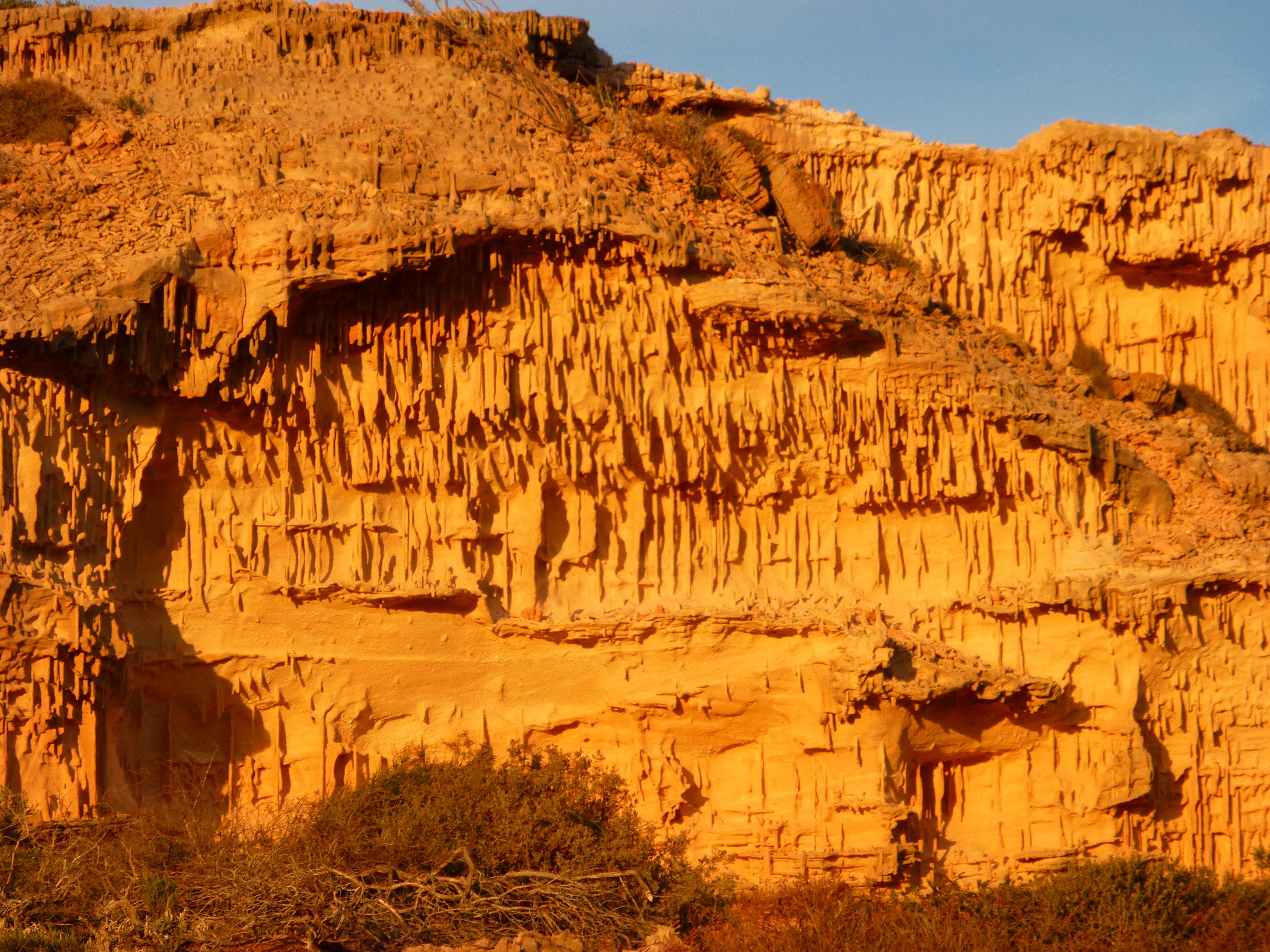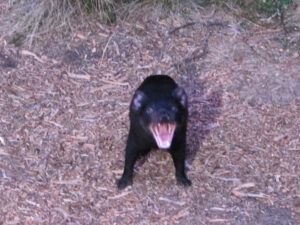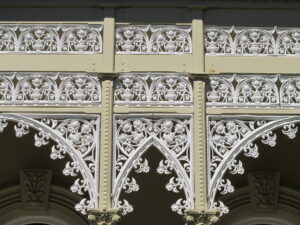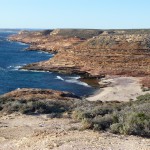
In this part, you can read about what we call Western Australia’s “Grand Ocean Road,” with its colorful sandstone bluffs, and discover the amazing stromatolites, without whom this blog – or anything else for that matter – would not be possible.
We’ve already written about the unusual landscape of the Pinnacles, a relatively short distance north of Perth. From the far northern end of Australia’s west coast, Coral Bay, we’ve told about swimming with the largest fish in the world.
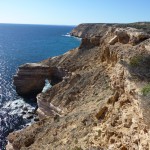
Between the two, if you’re open to subtle beauty, the drive of 1000 or so kilometers can be visually interesting in itself, if a bit repetitious at times. The region adjacent to Perth is called the Wheatbelt, with great patches of fertile farmland growing huge quantities of wheat, as well as citrus, mangoes, tomatoes and so on. After that, we passed a great deal of relatively moist outback full of trees and bush. When we were close to the coast, that landscape shifted to vast swatches of acacia-covered sand dunes alternating with bare, gleaming white sand hills – plus of course views of the clear blue waters of the sun-soaked ocean. Inland and north a bit more, in a region called Mid West, the ranching of free range cattle, sheep and goats predominates in a dryer ecology. (See our post on Rockin’ Down the Highway regarding the consequences.)
Still some remarkable sights stand out, a whole coast full of curiosities. These are the ones where you find most travelers stopping, as they were all reading from the same playbook.
Kalbarri and the “Grand” Ocean Road
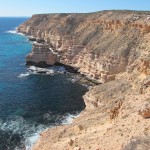
Most tourists in Australia know of the Great Ocean Road, the picturesque sandstone bluffs, islands and arches along the coastal highway west of Melbourne. We thought Western Australia offered a strong rival to this road, the twenty kilometer coastal section within Kalbarri National Park, on a spur that angles northwest off Route 1, the Northwest Coastal Highway. We were so impressed that we dubbed it the “Grand” Ocean Road.
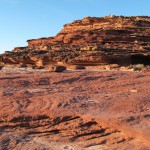
The best way to see the Grand Ocean Road is by bike or by foot, for trails run the length of it, but the sampler tour is dazzling enough. We were quite satisfied just stopping at some of the colorful overlooks with equally colorful names, and doing the kilometer or two walkways from those points.
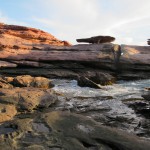
The names pretty much describe the special features of a stop. Natural Bridge, for example, shows off an arch from the bluffs to a separate chunk of sandstone offshore, while the nearby Island Rock viewpoint shows off a stand-alone pillar. As you walk atop the bluff, the cliffs shift in color, changing perspectives show off different features, and hidden coves reveal themselves in an ever unfurling display.
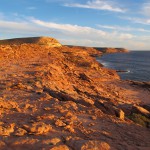
Our favorite walk connected Rainbow Valley and Mushroom Rock. The latter was a mushroom-shaped lump of granite teetering on a spindly stem about 20 meters above our heads. Below it, the ocean had burnished the shoreline rocks to a smooth finish, exposing colorful seams here and there. We reached the spot by way of a gorge of gently sloping red rock.
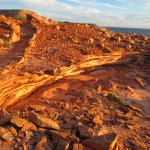
The best part was to follow. Rainbow Valley, a flat rubbly section of cliffs within 30 meters or so of the water, was awash in yellow, oranges and reds at sunset, a brightly lit display of compacted minerals amid the layers of sandstone.

These rainbow cliffs were even more unusual because of the lace-like drippings of sandy rock decorating many of their recesses. An eye full. If this place were near a populous city, it might be called the GREAT Ocean Road.
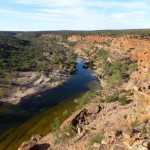
The rest of Kalbarri sprawls around 50 kilometers inland, where normally we could visit several canyons cut by the Murchison River. The most visited section, including Z-Bend and Nature’s Window, was closed off during the week for road reconstruction, but we made the most of our visit to the canyons upriver. After enjoying the lookout where the placid river winds through a wide gorge of rich red banks, we descended to the water.
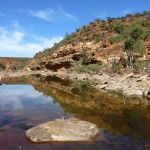
We easily crossed the shallow river on broad stones, then followed the sandy riverbed past its own rainbow cliffs, where no other tourists cared to wander. We were rewarded by a journey into a tranquil world, where we could enjoy birds like the white-faced heron and ringneck parrot, flowering bushes and many friendly kangaroos and wallabies.
Hutt Lagoon
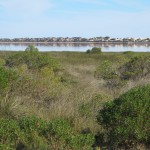
Between the Pinnacles and Kalbarri, we had passed an unusual lake that the locals clearly know, but we suspect is rarely visited by tourists. For us, it was merely an engaging lunch stop, one which was more intriguing as we passed it – and its 15-kilometer length (and just two wide) takes a while to pass. It is salty from ocean water even though sand dunes – some with vegetation and some more nude white dunes – form a permanent barrier between the lagoon and the sea. More interesting yet, the water has a pinkish color due to the unusual algae that thrives in it, producing the natural food coloring beta-carotene, harvestable Vitamin A (think carrots and sweet potatoes)!
The lagoon seems to have no apparent access points from the main road, at least not easily negotiated ones. We thought that was unusual, but we reckoned that was because the lake is still mined for salt and beta-carotene. There’s no messing with the algae, apparently.
Stromatolites at Hamelin Pool
Moving north from Kalbarri, you come to a trident-shaped area defined by two elongated bays. The left tine comprises Dick Hartog Island and the pristine dunes of the peninsula below it; the peninsula of the central tine offers Francois Peron National Park and the resort of Monkey Mia; the right tine is the mainland on the eastern side of Shark Bay.
As we headed up the central peninsula, we saw frequent signs touting the stromatolites, as well as the World Heritage status of the area. Our guidebook had certainly oohed and aahed about them. But even reading the description a few times, we had little idea what they might look actually look like. The big deal here is that they are among the oldest life-forms still on earth, going back many billions of years, and are supposedly responsible for oxygenating earth’s air back then so more advanced life-forms could develop (until man came along). Also, there are very few places in the world where they can still be found.
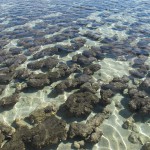
We arrived at what appeared to be a beach along the south end of huge Shark Bay, along with a steady stream of others whose cars, campervans and cycles were also drawn here by the zeal of their guidebooks. A short stroll and we were on a planked walkway. Looking at the bay, the horizon merged with the sky in the distance. The walkway zig-zagged amid the stromatolites for about a quarter kilometer through the clear, shallow, almost unmoving water. Set in the sandy sea bed, they looked like a randomly networked assemblage of lumps of clay or perhaps greyish flat-topped broccoli, only about 10 to 15 centimeters tall. According to Wikipedia, the interconnected lumps are actually colonies of cyanobacteria that have stuck together in a variety of basic forms. And so they were.
The modest sprawl of stromatolites was certainly unusual to see, even beautiful in the blue tinge of the water. But the excitement was mostly in that oxygenating story-line, which we could read on display signs along the walkway, featuring a cartoon character that looked like a stromatolite.

We heard one sign-reading visitor, whose children were not quite as thrilled as they ought to have been, exclaim, “We wouldn’t be here if it weren’t for the stromatolites!” For us oxygen breathers, it would seem, she was scientifically correct, but the indifferent children were likely wondering why they were here looking at this stuff today.
If you peered very carefully, however, you could actually see what she meant. Out of these inanimate lumps, a few barely noticeable bubbles popped to the surface and floated past. The stromatolites were doing what they had always done: giving us a breath of fresh air.
Hamelin sheep shearing station

It may not be in the guidebooks, but we found this old sheep shearing station a quick treat, one that happened by accident. With the name Hamelin, we just assumed we were supposed to turn onto the sandy road, though no one else was doing so. It turned out to be a few minutes drive before the real entrance to the pool.
We ended up at a large ranchhouse, with a virtually empty parking area, and absolutely no one other than us. After wandering a bit to reconnoiter, we were hailed by a man who let us know we had arrived by mistake at a site for camping and “station stays” in the renovated shearers’ quarters. Offering us a short tour, he filled us in on the location, and how it was still used for sheep shearing about a century after it was established. Though the shearers can stay elsewhere now so the tourists can use their old billet, sheep farmers still herd their woolly free-ranging sheep to the station during the right season (the dry summers when the thirsty sheep gather at the few waterholes). The rule, our guide explained, is that they’re your sheep if they’re on your side of the road or property line.
In part 2, you can read about the other curiosities along the coast, including a beach made completely of cockle shells and what it’s like to swim with grinning, four-meter wide manta rays.
(Also, for more pictures from Australia, CLICK HERE to view the slideshow at the end of the Australia itinerary page.)


